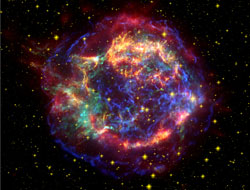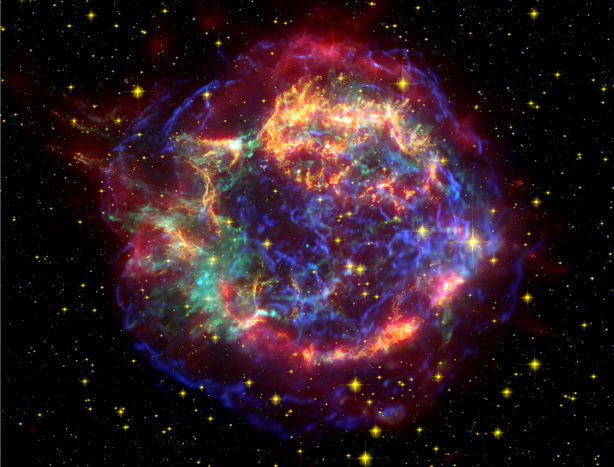A New Way to Make Elements
The neat order of chemistry’s periodic table hides some riddles. Physicists have long believed that exploding stars forge the heavier elements, but the accepted ways to assemble atomic nuclei in the hot flash of a supernova cannot explain the existence of some unusual isotopes. To create them, researchers now propose a new process that involves antineutrinos, ghostly particles that supernovae generate in huge numbers. The blazingly fast reactions, described in the 14 April PRL, may explain some of the rarer ingredients of our solar system and the distinct chemical patterns seen in primitive stars.
Stars fuse hydrogen and helium into elements as heavy as iron and nickel, but the heavier elements come mainly from supernovae, the explosions of giant stars that also create dense neutron stars or occasionally black holes at their cores. In the superhot explosion, most heavy elements arise when helium nuclei assemble into more massive nuclei, which then absorb neutrons that decay into protons. These rapid-fire reactions forge elements that climb the periodic table. But when nuclear astrophysicists studied these processes and others in detail, they found gaps. For example, the sun and meteorites contain some isotopes of the metals molybdenum and ruthenium with a high proportion of protons, but with no clear origins in the accepted series of reactions.
Now a European-led team thinks it knows why. Graduate student Carla Fröhlich of the University of Basel, Switzerland, and colleagues examined models of a supernova’s earliest moments. Last year they and a separate team of astrophysicists independently realized that there is a proton-rich region surrounding the fresh neutron star during the first few seconds of the explosion [1,2]. Isotopes that already have a high fraction of protons cannot capture these additional protons and progress to new elements because of the repulsive force from the positive charges jammed into their nuclei.
But Fröhlich and her colleagues found that some of the protons in this region transform into neutrons by reacting with antineutrinos streaming from the neutron star. These extra neutrons are critical during the early seconds when the material is still hot enough to make heavy, proton-rich isotopes. Some nuclei packed with the maximum allotment of protons grab a neutron and so generate enough binding force to capture another proton through the strong nuclear attraction. Within a few seconds, this cycle creates a series of stable isotopes containing as high a proportion of protons as nuclear forces allow–including the problematic varieties of molybdenum and ruthenium. “Without the antineutrinos creating a constant supply of free neutrons, this would not be possible,” says coauthor Gabriel Martínez-Pinedo of the research institute GSI in Darmstadt, Germany.
Other physicists view the process as a key step forward. “These isotopes have been an enigma for nucleosynthesis theory since its inception,” says Robert Hoffman of Lawrence Livermore National Laboratory in California, part of a team that has confirmed and expanded upon the new work with independent models of the proton-rich region.
Lighter isotopes created by this same process–notably strontium, yttrium, and zirconium–also may appear especially clearly in the most primitive stars, says astronomer Timothy Beers of Michigan State University in East Lansing. Old stars should have relatively clean imprints of these isotopes manufactured by the first supernovae and unmarred by chemical processing later on. Indeed, Beers notes, one of the most chemically primitive stars observed in the galaxy contains a surprising amount of strontium–far more than nucleosynthesis models had predicted, but consistent with the new study.
–Robert Irion
Robert Irion is a freelance science writer based in Santa Cruz, CA.
References
- J. Pruet, et al., Astrophys. J. 623, 325 (2005)
- C. Fröhlich et al., Astrophys. J. 637, 415 (2006)





